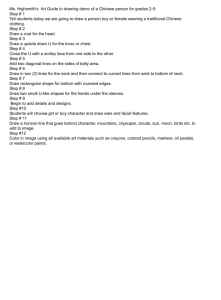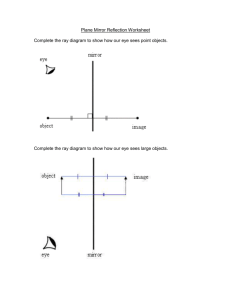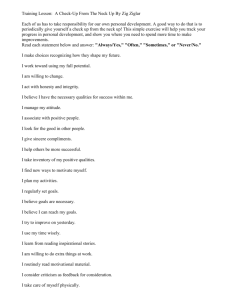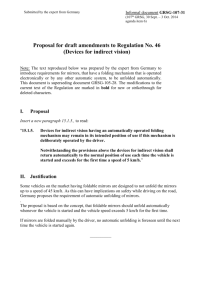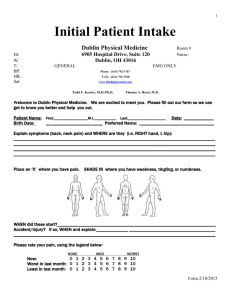Math 3080 § 1. First Midterm Exam Name: Solutions
advertisement
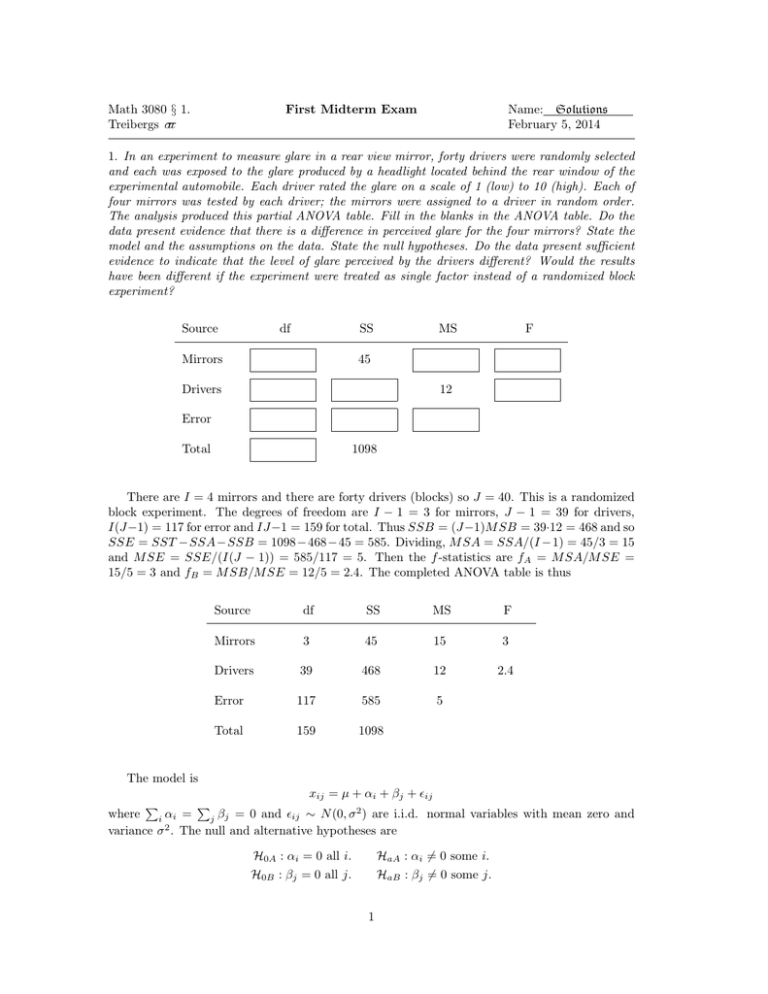
Math 3080 § 1. Treibergs σ− ιι First Midterm Exam Name: Solutions February 5, 2014 1. In an experiment to measure glare in a rear view mirror, forty drivers were randomly selected and each was exposed to the glare produced by a headlight located behind the rear window of the experimental automobile. Each driver rated the glare on a scale of 1 (low) to 10 (high). Each of four mirrors was tested by each driver; the mirrors were assigned to a driver in random order. The analysis produced this partial ANOVA table. Fill in the blanks in the ANOVA table. Do the data present evidence that there is a difference in perceived glare for the four mirrors? State the model and the assumptions on the data. State the null hypotheses. Do the data present sufficient evidence to indicate that the level of glare perceived by the drivers different? Would the results have been different if the experiment were treated as single factor instead of a randomized block experiment? Source df SS Mirrors MS F 45 Drivers 12 Error Total 1098 There are I = 4 mirrors and there are forty drivers (blocks) so J = 40. This is a randomized block experiment. The degrees of freedom are I − 1 = 3 for mirrors, J − 1 = 39 for drivers, I(J−1) = 117 for error and IJ−1 = 159 for total. Thus SSB = (J−1)M SB = 39·12 = 468 and so SSE = SST −SSA−SSB = 1098−468−45 = 585. Dividing, M SA = SSA/(I −1) = 45/3 = 15 and M SE = SSE/(I(J − 1)) = 585/117 = 5. Then the f -statistics are fA = M SA/M SE = 15/5 = 3 and fB = M SB/M SE = 12/5 = 2.4. The completed ANOVA table is thus Source df SS MS F Mirrors 3 45 15 3 Drivers 39 468 12 2.4 Error 117 585 5 Total 159 1098 The model is xij = µ + αi + βj + ij where i αi = j βj = 0 and ij ∼ N (0, σ 2 ) are i.i.d. normal variables with mean zero and variance σ 2 . The null and alternative hypotheses are P P H0A : αi = 0 all i. HaA : αi 6= 0 some i. H0B : βj = 0 all j. HaB : βj 6= 0 some j. 1 To test if the means are significantly different due to mirrors, see if the corresponding f value exceeds the critical f.05,3,117 ≈ f.05,3,100 = 2.70, which is the more conservative nearby number in Table A9. Thus fA = 3 > 2.70 so there are a significant difference in glare rating due to mirrors. If there had been no blocking, extra variability would have come from drivers and the corresponding M SE 0 would have been larger and the fA0 would have been smaller. Indeed, there would have been no sum square subtracted for blocking and SSE 0 = SSE + SSB = 953, dfE = 117+39 = 156 and M SE 0 = 953/156 = 6.11 so fA0 = M SA/M SE 0 = 12/6.11 = 1.96. Now the critical f.05,3,156 ≈ 2.70 and the differences due to mirrors would not have been significant. c InsectSprays, 6 different insecticides were applied to agricul2. In a canned data set from R, tural experimental units. 12 samples of each type were tested. Counts of insects surviving were reported. The data is analyzed as a single factor fixed effects model. The data indicate that there are significant differences in counts due to sprays. Use Tukey’s procedure to identify differences in the true average insect counts among the six sprays. Use the method of underscoring to illustrate your conclusions. Write a sentence summarizing your results. > a1 = aov(count ~ spray); summary(a1) Df Sum Sq Mean Sq F value Pr(>F) spray 5 2668.8 533.77 34.702 < 2.2e-16 *** Residuals 66 1015.2 15.38 --Signif. codes: 0 *** 0.001 ** 0.01 * 0.05 . 0.1 1 > tapply(count, spray, mean) A B C 14.500000 15.333333 2.083333 D 4.916667 E F 3.500000 16.666667 The model is xij = µi + ij where ij ∼ N (0, σ 2 ) are i.i.d. normal. The simultaneous Tukey CI’s for differences in all pairs of I = 6 means, µi − µj are given by r M SE X i· − X j· ± q(α, I, I(J − 1)) J where the studentized range q(.05, Table A10. It follows that if the differences p6, 66) ≈ 4.16 from p are not significant if |µi − µj | < q M SE/J = 4.16 ∗ 15.38/12 = 4.71. We sort the means from smallest to largest. C E D 2.083333 3.500000 4.916667 -------------------------------- A B F 14.500000 15.333333 16.666667 --------------------------------- Then we see that |µC − µE |, |µC − µD |, |µE − µD |, |µA − µB |, |µA − µC | and |µB − µC | are less than 4.71 but all other pairs are greater. The resulting underscoring pattern has two groups of means that are not significantly different. We may summarize the result as follows: The counts for sprays C, D and E are not significantly different from one another; the counts for sprays A, B and F are not significantly different from one another; but the counts for any pair one from the first group and the other from the second group differ significantly. 2 3. Suppose that in a one factor fixed effects model where i.i.d. ij ∼ N (0, σ 2 ) xij = µi + ij three different treatments are measured with two samples per treatment. If we observe Treatment 1 2 xi 1 19 15 17 2 16 20 18 3 29 21 25 Define what an effect αi is in general. What is the estimator of α c3 from this data? What is a residual? What is the residual r3,1 for this data? What is SSA for this data? What is M SE for this data? An effect is the difference of the population mean in the presence of a factor and the grand P population mean. If we put µ = I1 i µi then the effect αi = µi − µ. An estimator is αbi = P µbi − µ̂ = X i· = X ·· so in this case α c3 = x3· − x·· = 25 − 20 = 5 where X i· = J1 j Xij and so P here x·· = I1 i xi· = 13 (17 + 18 + 25) = 20. The residual is the difference between the observed and the fitted value. In this case, Rij = d Xij − X ij . In particular here r3,1 = x3,1 − x3,1 = 29 − 25 = 4 . By definition, I X J X SSA = (X i · −X ·· )2 i=1 j=1 so here SSA = 2 (17 − 20)2 + (18 − 20)2 + (25 − 20)2 = 2(9 + 4 + 25) = 76 . By definition, I M SE = 1X 2 S I i=1 i so here M SE = 1 3 1 1 (19 − 17)2 + (15 − 17)2 + (16 − 18)2 + (20 − 18)2 2−1 2−1 1 1 + (29 − 25)2 + (21 − 25)2 = (8 + 8 + 32) = 16 . 2−1 3 Other formulas may also be used. But as always, to show that the correct procedure is being used, it is important to write the formula before plugging values. 3 4. Artificial joints were studied in an article by Macdonald et al in Proceedings of the Institution of Mechanical Engineers, 2000. They compared two materials and three taper neck lengths. Five measurements of friction were made for each combination of material and neck length. State the model and the assumptions on the data. State the null hypotheses. From the ANOVA table, what conclusions do you draw? For each of the six diagnostic plots for this data on the next page, state what the plot says the data or about how well the data satisfies the hypotheses. Taper Material CPTi-ZrO2 CPTi-ZrO2 CPTi-ZrO2 TiAlloy TiAlloy TiAlloy Neck Length Short Medium Long Short Medium Long Coefficient of Friction 0.254 0.220 0.320 0.175 0.195 0.185 0.296 0.131 0.281 0.259 0.178 0.180 0.289 0.197 0.150 0.184 0.220 0.329 0.118 0.154 0.196 0.481 0.158 0.156 > a1=aov(y ~ Material * Neck); summary(a1) Df Sum Sq Mean Sq F value Pr(>F) Material 1 0.059052 0.059052 23.6304 5.913e-05 *** Neck 2 0.028408 0.014204 5.6840 0.009533 ** Material:Neck 2 0.009089 0.004544 1.8185 0.183924 Residuals 24 0.059976 0.002499 4 0.177 0.178 0.198 0.201 0.199 0.210 The model is a two factor fixed effects model with replication. There are I = 2 materials, J = 3 neck lengths and K = 5 replicates per cell. The model is xijk = µ + αi + βj + γij + ijk where the sum over any one index for αi , βj and γij is zero and ijk ∼ N (0, σ 2 ) are i.i.d. normal variables. The null and alternative hypotheses are H0A : αi = 0 all i. HaA : αi 6= 0 some i. H0B : βj = 0 all j. HaB : βj 6= 0 some j H0AB : γij = 0 all i, j. HaAB : γij 6= 0 some i, j. From the ANOVA table, the interactions have large p-value so H0AB cannot be rejected and so the interactions are plausibly zero. On the other hand the p-values for neck and material are small so both H0A and H0B are rejected. Both have significant effects on the coefficient of friction. The various diagnostic plots give informatin about the data and how well the data satisfies the assumptions. 1. Observed vs. Fitted. Plot shows that the the variation seems to increase with fitted value, so that there may be doubt on equality of variance for each cell. 2. Boxplot. The means are slightly different for different neck sizes. We also see that the spread varies for different levels of the factor neck so that there may be doubt on equality of variance for each neck size. 3. Design Plot. Shows mean friction for different levels of the two factors. Both neck and material means vary with factor levels. 4. Observed vs. Factors. Gives a dot plot for every factor combination. Not only are the centers dependent on factor combinations but the two materials seem to have different spreads showing the equality of variance for each cell may be in doubt. 5. Standardized Residuals vs. Fitted. This time the observations are centered and divided by the grand standard deviation. Still see the horn pattern: the variability increases with fitted value putting doubt on the equality of variance. 6. QQ Normal Plot of Standardized Residuals. This one has a pronounced “N” shape indicating heavy tails for the residuals. This is another indicator that the epsilons may not be normally distributed. 5 5. PVC is made by polymerizing a vinyl chloride monomer in a batch chemical reactor where it is mixed with water to produce a resin of desired molecular weight. A 1998 study in Quality Engineeringmeasured the effect of operators and resin railcars on the particle size of the resin. The operators and railcars were both randomly selected from their respective populations because the objective of the study was to measure the variation due to operators and due to railcars. Two resin samples were selected from each operator-railcar combination. Is this a fixed effects, random effects or mixed model? State the model and the assumptions on the data. Is there an interaction due to operator and railcar? State the null and alternative hypotheses. State the test statistic. What is your conclusion? What can you conclude about the effect of railcar on particle size? State the null and alternative hypothesis, the test statistic, the level 0.05 rejection region and your conclusion. > a1=aov(size ~ Operator * Railcar); summary(a1) Df Sum Sq Mean Sq F value Pr(>F) Operator 2 20.902 10.451 7.1776 0.003603 ** Railcar 7 283.871 40.553 27.8516 4.845e-10 *** Operator:Railcar 14 14.142 1.010 0.6937 0.758885 Residuals 24 34.945 1.456 This is a random effects model. We assume xijk = µ + Ai + Bj + Cij + ijk where all the random variables Ai , Bj Cij and ijk are independent RV’s that satisfy 2 Ai ∼ N (0, σA ), 2 Bj ∼ N (0, σB ), 2 Cij ∼ N (0, σC ), ijk ∼ N (0, σ 2 ). The null and alternative hypotheses are 2 H0A : σA = 0. 2 HaA : σA 6= 0. 2 H0B : σB = 0. 2 HaB : σA 6= 0. 2 H0AB : σC = 0. 2 HaAB : σC 6= 0. To test for variability due to interaction of the two factors, the statistic is fAB = M SAB/M SE = 2 is 0.6937 which has a p-value 0.758885. Thus we cannot reject H0AB and conclude that σC plausibly zero: there is no significant variability of particle size due to interaction. To test for variability due to railcar, the statistic is fB = M SB/M SAB = 40.553/1.010 = 40.151. We reject H0B if fB exceeds the critical value f (0.05, 7, 14) = 2.76 from table A9. Thus 2 we reject H0B and conclude that σB is significantly nonzero: there is variability on particle size due to railcars. 6
